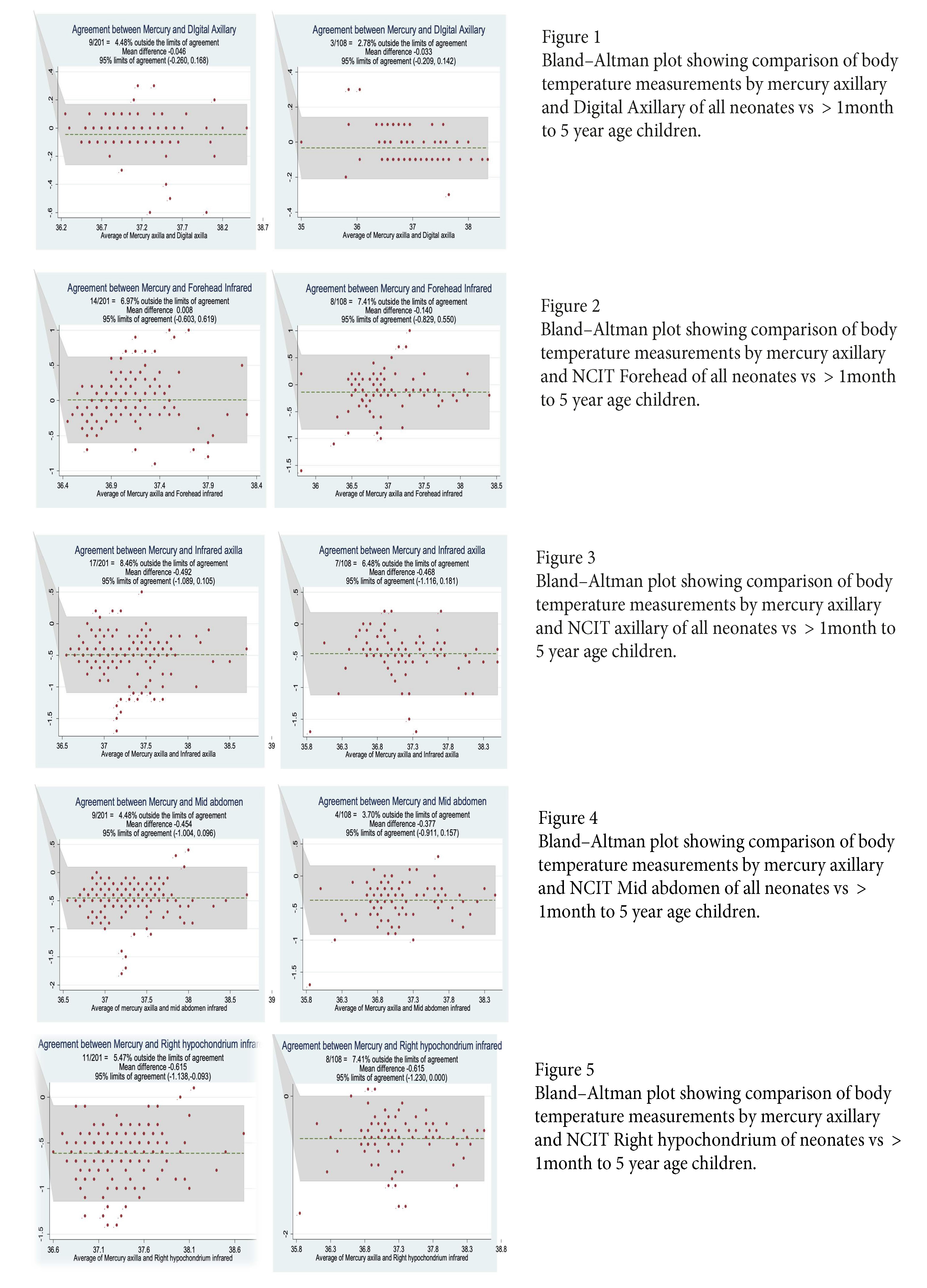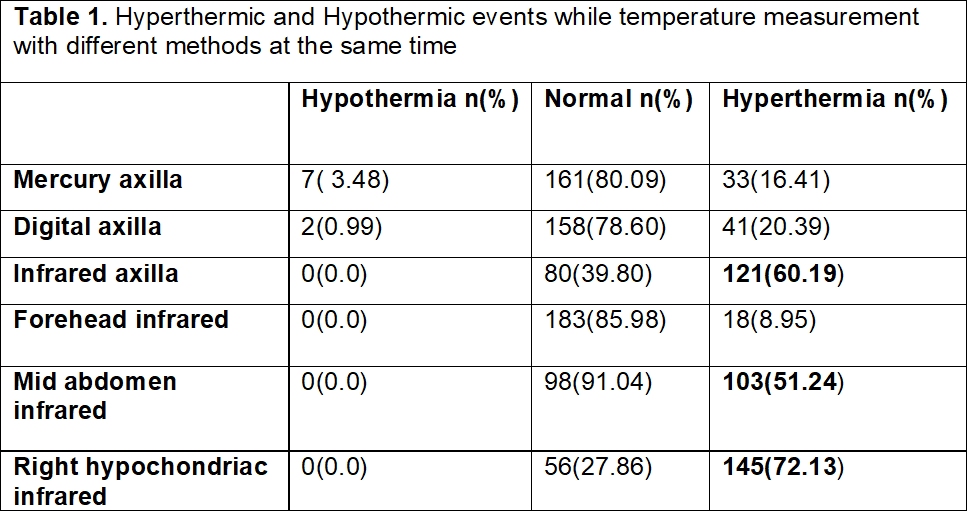Hospital Medicine: Clinical
Category: Abstract Submission
Hospital Medicine: Clinical NOS
332 - Temperature Monitoring in Children: An Agreement Study
Saturday, April 23, 2022
3:30 PM - 6:00 PM US MT
Poster Number: 332
Publication Number: 332.214
Publication Number: 332.214
RUSHI B. BAROT, BHAIKAKA UNIVERSITY, ANAND, Gujarat, India; Dipen V. Patel, Bhiakaka University, Karamsad, Gujarat, India; MAYUR SHINDE, BHAIKAKA UNIVERSITY, Anand, Gujarat, India; Ajay G. Phatak, Bhaikaka University, Karamsad, Anand, Gujarat, India; Somashekhar M. Nimbalkar, Bhaikaka University, Karamsad, Gujarat, India

Somashekhar M. Nimbalkar, n/a
Professor of Neonatology
Bhaikaka University
Karamsad, Gujarat, India
Presenting Author(s)
Background: Temperature measurement is one of the essential parts of the care of children. Non-contact infrared thermometers (NCITs) can be used to measure temperature rapidly and non-invasively, potentially causing less distress to children than conventional methods. Inaddition, since NCITs do not involve any contact with body surfaces, the risk of cross-infection is negligible, and neither disinfection nor disposable probe covers are needed. The use of NCITs at the forehead is widely studied, but other potential sites like axilla or abdomen are yet to be explored by temperature monitoring with NCITs.
Objective: To compare the agreement of temperature recordings of the "gold standard" axillary temperature by mercury thermometer with i) axillary temperature by a digital thermometer, ii) NCIT at forehead, iii) NCIT at axilla, iv) NCIT at mid-abdomen, and v) NCIT at right hypochondriac areas. We also compared the incidence of hypothermia and hyperthermia between these groups.
Design/Methods: Participants of age < five years were enrolled irrespective of their gest age, birth weight, and diagnosis through purposive sampling from postnatal wards, pediatric wards of a teaching university-affiliated hospital. Temperature readings were recorded using NCIT at forehead, NCIT at mid abdomen above umbilicus, NCIT at right hypochondrium, NCIT at right axilla, digital thermometer at right axilla and using glass mercury thermometer at right axilla. All the readings were obtained in this order when routine temperature monitoring was done. The agreement between various methods were presented as Mean Difference (95% Confidence Limits of the Difference) using Bland-Altman Analysis. Mean difference within 0.2°C , CL Within +- 0.5°C and < 5% outside 95% CL were considered to be of good agreement.
Results: We enrolled 102 participants and divided them into A) Neonates and B) 1 month to 5 years of age, from which 309 samples were taken. There was good agreement between mercury axillary with digital axillary (Figure 1), and acceptable agreement between mercury axillary with NCIT at Forehead (Figure 2). Whereas the agreement between mercury axillary vs NCIT Axillary (Figure 3), NCIT Mid abdomen (Figure 4), and NCIT Right hypochondrium was poor (Figures 5). NCIT at axilla, at mid-abdomen and right hypochondrium demonstrated more hyperthermia (Table 1 with Neonatal data and Table 2 with Pediatric Data).Conclusion(s): There was good agreement of digital axillary temperature followed by NCIT forehead with mercury axillary temperature, while non-touch recording at other sites had poor agreement.
Bland-Altman Plots showing comparison of Body Temperature measurements The Images on the left show the neonatal data while the images on the right show pediatric data.
The Images on the left show the neonatal data while the images on the right show pediatric data.
Hyperthermic and Hypothermic events measured with different methods at same time in Neonates NCIT shows more hyperthemic events in axilla, mid-abdomen and right hypochondriac areas
NCIT shows more hyperthemic events in axilla, mid-abdomen and right hypochondriac areas
Objective: To compare the agreement of temperature recordings of the "gold standard" axillary temperature by mercury thermometer with i) axillary temperature by a digital thermometer, ii) NCIT at forehead, iii) NCIT at axilla, iv) NCIT at mid-abdomen, and v) NCIT at right hypochondriac areas. We also compared the incidence of hypothermia and hyperthermia between these groups.
Design/Methods: Participants of age < five years were enrolled irrespective of their gest age, birth weight, and diagnosis through purposive sampling from postnatal wards, pediatric wards of a teaching university-affiliated hospital. Temperature readings were recorded using NCIT at forehead, NCIT at mid abdomen above umbilicus, NCIT at right hypochondrium, NCIT at right axilla, digital thermometer at right axilla and using glass mercury thermometer at right axilla. All the readings were obtained in this order when routine temperature monitoring was done. The agreement between various methods were presented as Mean Difference (95% Confidence Limits of the Difference) using Bland-Altman Analysis. Mean difference within 0.2°C , CL Within +- 0.5°C and < 5% outside 95% CL were considered to be of good agreement.
Results: We enrolled 102 participants and divided them into A) Neonates and B) 1 month to 5 years of age, from which 309 samples were taken. There was good agreement between mercury axillary with digital axillary (Figure 1), and acceptable agreement between mercury axillary with NCIT at Forehead (Figure 2). Whereas the agreement between mercury axillary vs NCIT Axillary (Figure 3), NCIT Mid abdomen (Figure 4), and NCIT Right hypochondrium was poor (Figures 5). NCIT at axilla, at mid-abdomen and right hypochondrium demonstrated more hyperthermia (Table 1 with Neonatal data and Table 2 with Pediatric Data).Conclusion(s): There was good agreement of digital axillary temperature followed by NCIT forehead with mercury axillary temperature, while non-touch recording at other sites had poor agreement.
Bland-Altman Plots showing comparison of Body Temperature measurements
 The Images on the left show the neonatal data while the images on the right show pediatric data.
The Images on the left show the neonatal data while the images on the right show pediatric data.Hyperthermic and Hypothermic events measured with different methods at same time in Neonates
 NCIT shows more hyperthemic events in axilla, mid-abdomen and right hypochondriac areas
NCIT shows more hyperthemic events in axilla, mid-abdomen and right hypochondriac areas